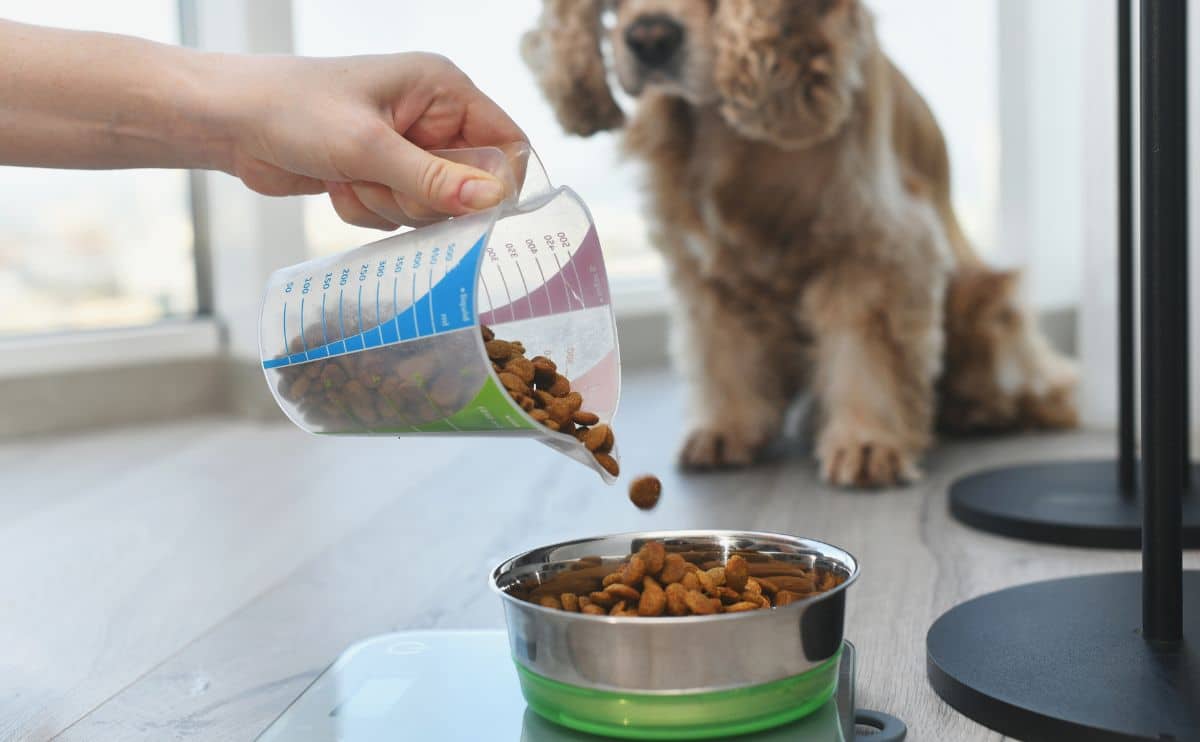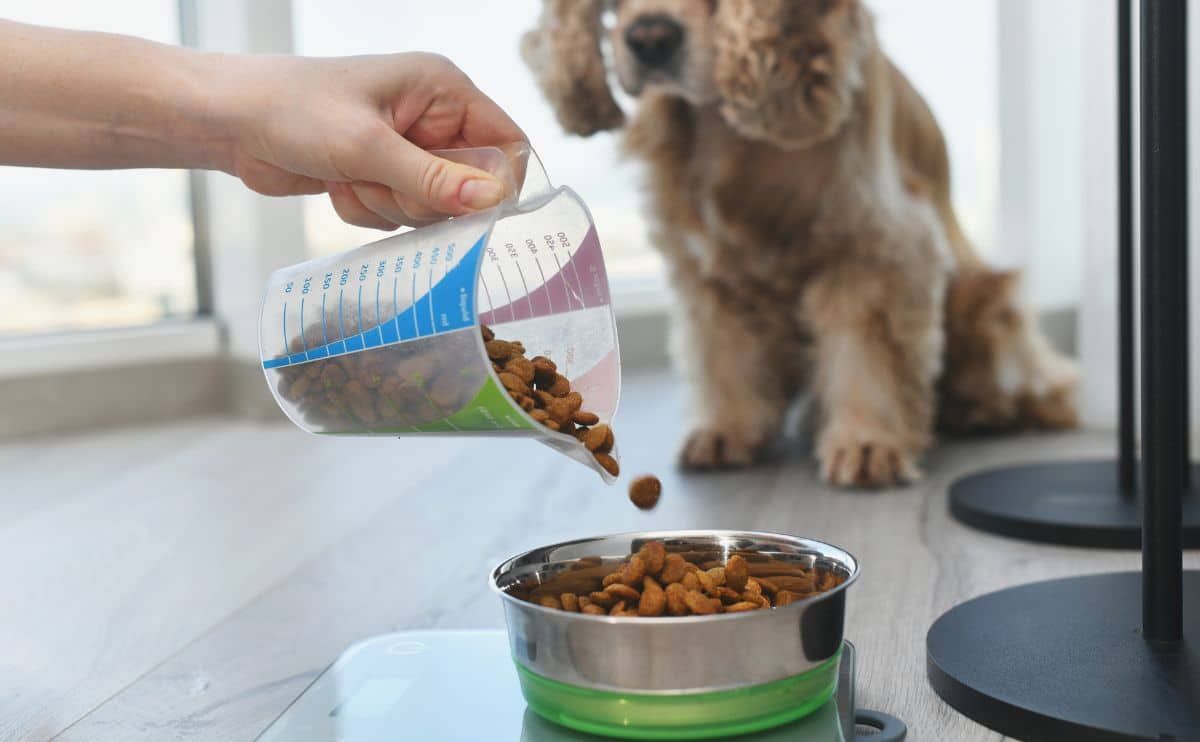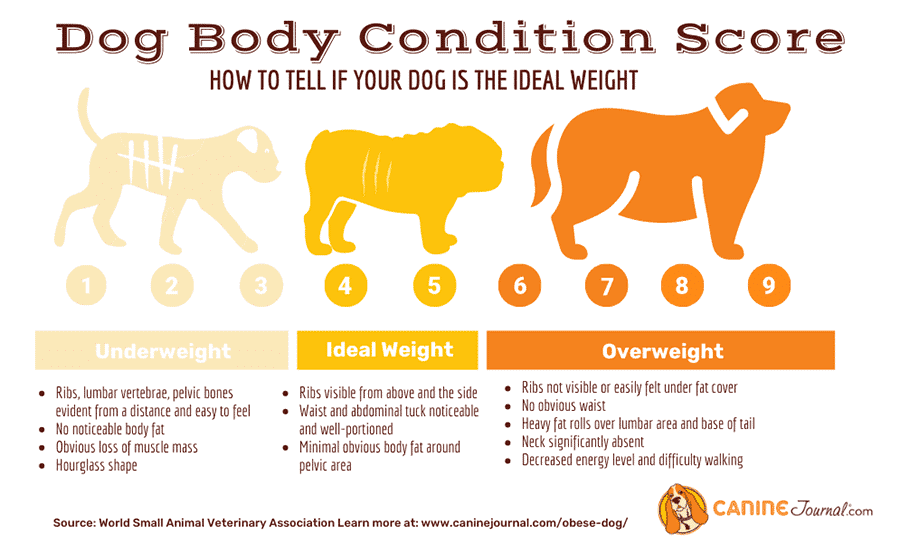
To keep the lights on, we receive affiliate commissions via some of our links. Our review process.

Giving your furry friend a nutritious, well-balanced diet and not overfeeding or underfeeding are among the most important things you can do for his lifelong health. We’ll help you determine how much food to give your dog and how many times he should eat each day, as well as any special feeding considerations you need to consider depending on your pup’s health needs.
Why Is Feeding My Dog The Right Amount So Important?
Contents
One of the most frequent questions we see from pup owners is, “how much should my dog eat?” Knowing how much to feed your dog is crucial for his health. Being overweight or underweight can lead to serious health problems. And this can occur in smaller dogs who are just a few pounds under or over their ideal weight.
Underfed dogs can develop such conditions as chronic lethargy, dehydration, a weakened immune system, severe nutritional deficiencies that affect organ function, and cognitive problems. More common, however, is what experts say has become an epidemic of obesity in pets.
The Association for Pet Obesity Prevention (APOP) reports that over 55% of dogs in the U.S. are overweight or obese. Being overweight can shorten your dog’s life and increases the risk of diabetes, heart disease, cancer, liver or kidney problems, and arthritis.
How Much Should I Feed My Dog?
Unfortunately, there’s no straightforward answer to this question. Several important factors affect how much food you should be giving your pup:
- Your dog’s life stage (puppy, adult, or senior)
- Type and brand of food
- Your dog’s weight
- Activity level
- Your dog’s body condition
- Number of meals per day
As you can imagine, it takes a bit of legwork to determine the ideal amount of food your furry friend should consume. Your best resource for nutritional guidance is your dog’s regular veterinarian. But you can also follow the steps below to determine how much you should feed your pup.
Dog Feeding Chart By Weight
The best place to start is to follow your dog food’s label, which can quickly answer the question, “how many cups of food should I feed my dog?” These feeding charts vary by type of food, brand, and caloric content of each formula. And be aware that all have their limitations.* Most also give you the daily amount to feed your pup, so you’ll need to divide that total by the number of meals you give your dog each day. Here’s an example of a typical adult dry dog food feeding chart.
| Adult Dog Size | Dry Food Per Day |
|---|---|
| 3-5 lbs | 1/2 to 3/4 cups |
| 5-10 lbs | 3/4 to 1-1/4 cups |
| 10-20 lbs | 1-1/4 to 1-3/4 cups |
| 20-30 lbs | 1-1/3 to 2-1/3 cups |
| 30-40 lbs | 2-1/3 to 3 cups |
| 40-60 lbs | 3 to 4 cups |
| 60-80 lbs | 4 to 5 cups |
| 80-100 lbs | 5 to 5-3/4 cups |
| 100-125 lbs | 5-3/4 to 7 cups |
| 125-150 lbs | 7 to 8 cups |
| 150-175 lbs | 8 to 9 cups |
*Feeding charts are generalized and geared toward dogs who are at a healthy weight with an average activity level. They also don’t take into account any special health concerns your canine companion may have. But there are ways you can further nail down how much to feed your dog after starting with your pup’s food feeding chart.
Factor In Your Dog’s Activity Level
Take the information from your furry friend’s dog food feeding chart and then consider his overall activity level and daily exercise. This can help you determine whether you should feed him on the lower or upper range of the label’s recommended daily amount.
For example, if you have a couch-potato Basset Hound, you likely want to give him a bit less food than the feeding chart recommends. Alternatively, if you have an Australian Shepherd who’s a constant ball of energy, you’ll probably want to feed a little more than the suggested range.
Determine Your Dog’s Body Condition Score
Evaluating your dog’s current body condition can help tell you if he’s too thin, at a healthy weight, or overweight. Then, you can tweak his daily caloric intake (if needed) to help him gain or lose weight. Once your dog has reached his ideal weight, you’ll need to adjust his portions. If your dog isn’t currently at a healthy weight, it’s best to consult your vet for the most appropriate feeding plan for your canine companion and to check him out for any possible underlying health conditions.
To determine your pup’s body condition score (BCS), examine his ribs, abdomen, and waistline by sight and touch. If your dog’s score is a 4-5, then weigh him to know his ideal weight. If he falls between a 1-3, he likely needs to gain weight, and a 6-9 means he needs to shed some pounds.

Use A Calorie Calculator
An alternative method is to use an online calorie calculator that will factor in your dog’s BCS, but these still have some limitations in terms of factoring in your pup’s activity level and daily exercise.
Don’t Forget To Factor In Dog Treats
When determining how much your dog should eat each day, it’s crucial to factor in the caloric content of any treats, table scraps, or supplements you give him. (FYI, experts advise against feeding your pup table scraps for many reasons.) Some dog treats and health supplements have more calories than you might think, and if you give these to your furry friend regularly, it could lead to weight gain.
If your pup is a huge treat fan, look for healthy, low-calorie options. We recommend Fruitables Skinny Minis or Wellness CORE Jerky Bites. And if your vet has determined you should give your dog a daily joint supplement or another type of supplement for his health needs, you’ll need to subtract the calories of that from his daily food intake.
How Much To Feed Puppies & Seniors
Senior dogs typically require fewer calories than adults because their activity and metabolism have slowed down. Once your canine buddy has reached his senior years, most vets advise putting him on a dog food formulated specifically for elder dogs. Typically, these formulas have fewer calories and less fat content, which are appropriate for their slowing activity and metabolism.
Puppies are in an entirely different category when it comes to feeding needs. It’s extremely important to follow feeding guidelines for your puppy because these requirements change every few weeks or months as he grows quickly. See our in-depth puppy feeding guide for a detailed puppy feeding chart by weight/age and much more.
How Often Should I Feed My Dog?
Ideally, most adult dogs should eat at least two meals per day, approximately 12 hours apart. Likewise, three meals spread out equally during the day is another excellent option. If your dog’s breed is at a higher risk for canine bloat, it’s recommended to feed smaller, more frequent meals.
When you feed your pup is entirely up to your daily schedule, but it’s important to set up regular feeding times and stick with them. Dogs thrive on routine, so they’ll be most content with meals served around the same time each day.
Your Best Dog Food Options
Are you considering switching to a different dog food? If you haven’t settled on a new diet, we encourage you to see our various dog food reviews. We’ve researched hundreds of types, brands, and formulas to help you narrow down your options. See our recommended foods for any age, diet type, and health concern, the best dog food delivery services for puppies and adult dogs,and our top picks for fresh dog food.
Tagged With: